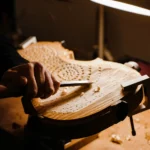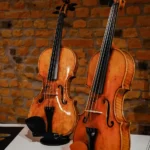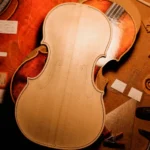A Guide To the Violin Bridge & Soundpost
Back to BlogAs musicians, we are constantly striving to improve our violin’s sound. One of the easiest ways to check if your violin’s sound is up to snuff is to physically examine the violin bridge and soundpost. These two small but important parts are responsible for carrying the vibration from the top of the violin to its bottom (the body). So, they surely affect your overall violin sound.
The purpose of this guide is to help you understand how these two lesser-known parts of the violin work together and their role in your masterpiece. We’ll do that by explaining what the violin bridge and soundpost are, how they affect your violin’s sound, and how you can go about adjusting them.
Violin Bridge
A violin bridge is a key component of your violin, so you definitely need to know all there is to know about it and its importance. The violin bridge not only supports the strings and regulates their height, but also transmits the strings’ vibration to a bigger surface – wait, what does that mean? It means that, by playing the violin with a bow, you apply energy to the strings, setting them into vibratory motion, creating musical sounds.
However, the strings alone displace just a small air volume while vibrating, so the bridge conducts the strings vibration to a larger surface that displaces a larger air volume, thus producing louder sounds to the surrounding air. The larger surface is the violin top, where the bridge rests. It is a resonant area that helps to amplify the sound. Additionally, the bridge also acts as an acoustic filter, suppressing specific undesirable frequencies. (This is a bit more complex; let’s just not get that much into physics here).
Violin Bridge Adjustments
The bridge receives a lot of pressure when the strings are vibrating, so it might happen to its shape to be twisted, slant, or warped; always make sure that it is standing vertically straight in the top plate, with a sharp 90 degrees angle. This check improves the resistance needed to support the strings’ pressure, prevents you from having to change the bridge every now and then and it will maintain the set-up in its ideal configuration. When adjusting it, make sure to losen a bit of the strings to facilitate the movement. Do it carefully and gently; after all, we all know stringed instruments are delicate.
If the bridge’s shape is already damaged, that’s a sign that you should visit a luthier; this might be causing problems to your sound.
Violin Soundpost
The Violin soundpost is one of those components of the violin that affects the tone quality. The soundpost is a small, rounded, tapering cylinder that is placed by friction, close to the bridge’s foot in the treble side, and it also acts as a supporter for the top plate. It transfers the vibration to the backplate, turning the violin’s body into a resonant box.
The soundpost is the most important part of a violin since it is responsible for producing the sound. The violin strings are stationary, but the soundpost must be adjusted in order to establish an ideal tension. The main disadvantage of having a poorly positioned or thin soundpost is that there will be difficulties intoning the open strings.
Slight changes in the violin soundpost position change the sound in a different way. Here are some of them:
- Placing it closer to the bridge enhances the lower strings, and the sound will be brighter. If you place it further from the bridge, it loses its brightness and makes the sound a little rounder.
- Placing it towards the inner side, towards the center, benefits the bass side and makes the sound darker. On the other hand, placing it towards the outside, closer to the f-hole, the sound will be more focused, tending to be clearer.
Always remember, the idea is to seek a balanced sound to the taste of the musician. Its adjustment is as complex as the difference it can make to the violin’s sound. Make sure you go to a luthier every time you need to correct it!
Your violin bridge and soundpost are parts that greatly affect the overall violin’s sound. They need to be in good shape to get the best sound out of your violin. Learn a little more about your instrument and have better sound by taking care of these two parts.
Keep an eye out on our Facebook, and Instagram pages for tips on how to look after your violin.









